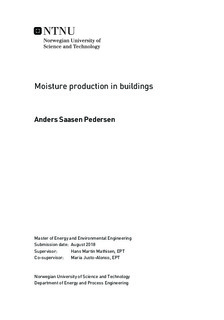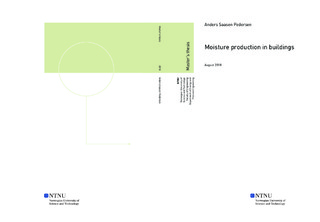| dc.description.abstract | This master thesis is investigating the moisture production from indoor activities, and how it influences the indoor relative humidity. The main goal is to verify a moisture production model for residential buildings, currently under development at NTNU. The first three chapters of the thesis presents the mathematical background to indoor moisture production, and the state of the art research on the area. A suggested calculation method on how the release of moisture from an indoor activity can be quantified by measurements is presented. The second part of the thesis present the moisture production model and the planned method on how the model can be verified. By conducting a series of showering experiments, and using the suggested calculation method to quantify the moisture produced, the verification was attempted. The third part presents the results from a series of conducted experiments performed in Living Lab at NTNU. The data from the experiments is processed and compared to the existing model, and discussed.
Moisture in general is the number one cause of building related damages, whereas about 6 % -8 % is directly related to indoor moisture. With increased demand for building tightness, it is crucial to have a properly sized mechanical ventilation system to ventilate the exec moisture out of the building, preventing it to accumulate. An indoor relative humidity of above 70 % gives favorable conditions for mold and bacterial grown on indoor surfaces, and can worsen asthmatic symptoms. Monitoring and studying the indoor levels of humidity is essential in order to understand and prevent these situations.
A number of processes and activities in an indoor environment generates moisture. Breathing, showering, bathing, cooking, cleaning, and drying of clothes are all generating moisture to the surrounding air. However, the indoor moisture production rates varies greatly between the different sources, as seen from research. For showering, the moisture production varies with a number of parameters. Water temperature, flow rate of water and the length of the shower is just some of the variables determining the total moisture production. These three parameters are used as variables during the experiments in Living Lab.
The ultimate goal of the moisture production model is to prevent frosting and condensation in the rotary heat exchanger of the air- handling unit. By creating a model that can predict indoor relative humidity fluctuations in a building and how the humidity is recycled through the heat exchanger, these unwanted effects could ultimately be avoided. The model uses data on moisture production from a number of sources, and by the help of input data on occupant behavior from the user, the indoor relative humidity levels is mapped.
This thesis focuses on verifying the moisture production from showering. Showering is the most intensive indoor moisture producing source, as it has the ability to saturate the surrounding air. By conducting a series of showering experiments, while changing different parameters, the moisture production, along with the transient development in relative humidity has been mapped. From the results, it can be seen that the moisture production calculated from experimental data is higher than suggested data from the literature. The experiments showed a total release of moisture ranging from 200 g/shower 750 g/shower. The literature suggest values from 200 g/shower to 400 g/shower.
The transient development in relative humidity from the experiments is compared to the simulated results from the moisture production model. These relation is very similar until two minutes after the shower has been turned off. At this point the decrease rate slows down in real life, while the model continues to descend at the same rate. This difference makes the total time for the relative humidity to reach a stationary condition merely 40 minutes for the model, while in reality it takes from 2 hours 2.5 hours. This is assumed to have to do with the transition from water vapor present in the air, which is rapidly ventilated out, to the evaporation of liquid water left in the bathroom, which takes a longer time. The model does not take this into consideration, and it is suggested that it should.
The secondary goal of the thesis is to conduct a literature review on whether moisture buffering can be utilized to reduce the peaks in indoor relative humidity on not. Based on the research it is suggested that the effect should be implemented into the model at a later stage. The accuracy of the model is at this stage not high enough that this effect is essential. From the literature it is shown that the capability of a material to reduce the peaks in relative humidity is up to 30 % if used correctly. The author does however doubts that this can happen within a shower, as the moisture is released at such high rate, and ventilated out at almost equal rate. The moisture buffering is thus assumed ineffective on damping the effect from showering. | |

